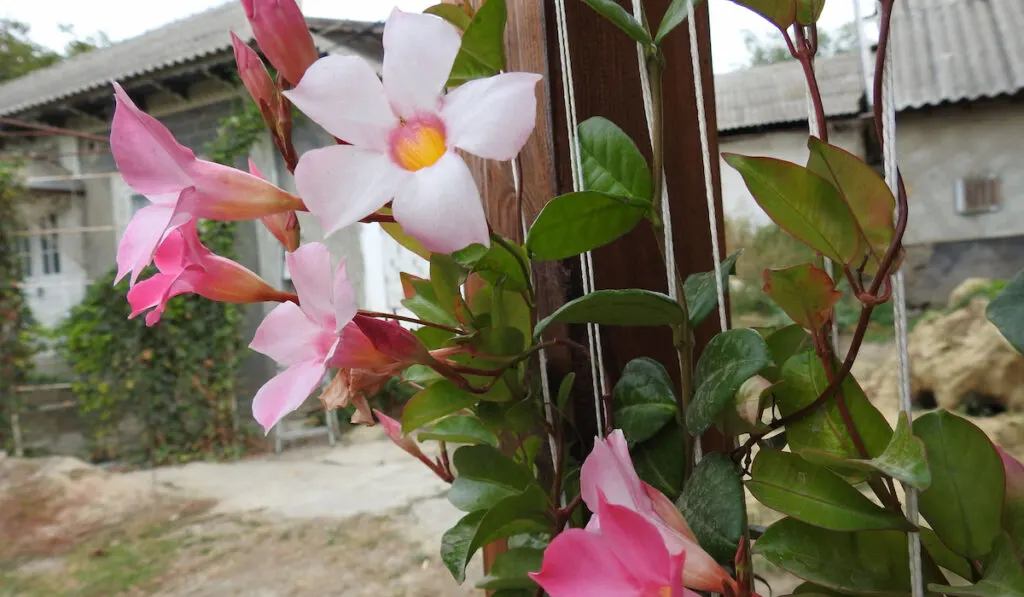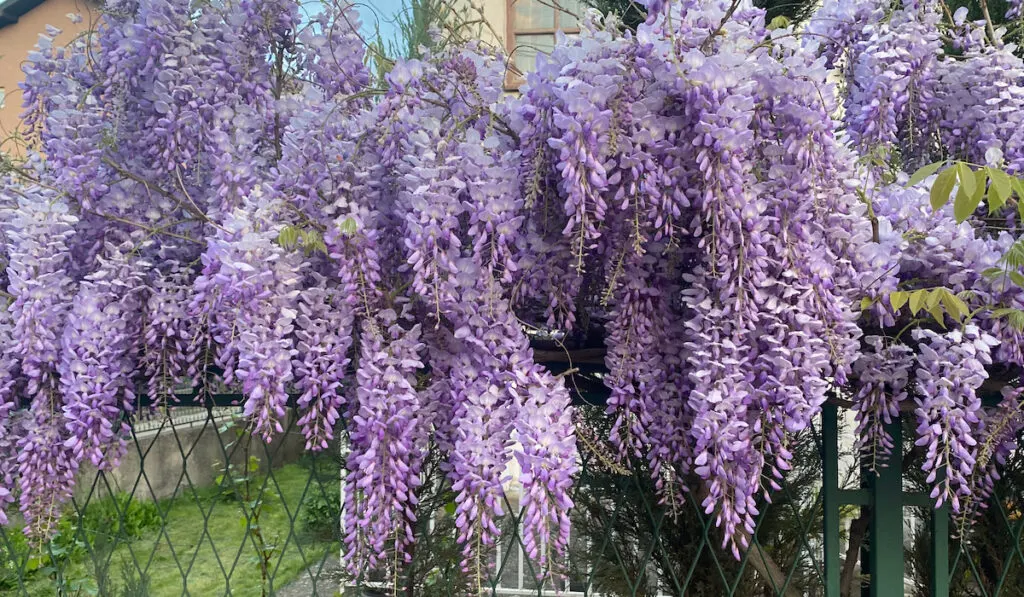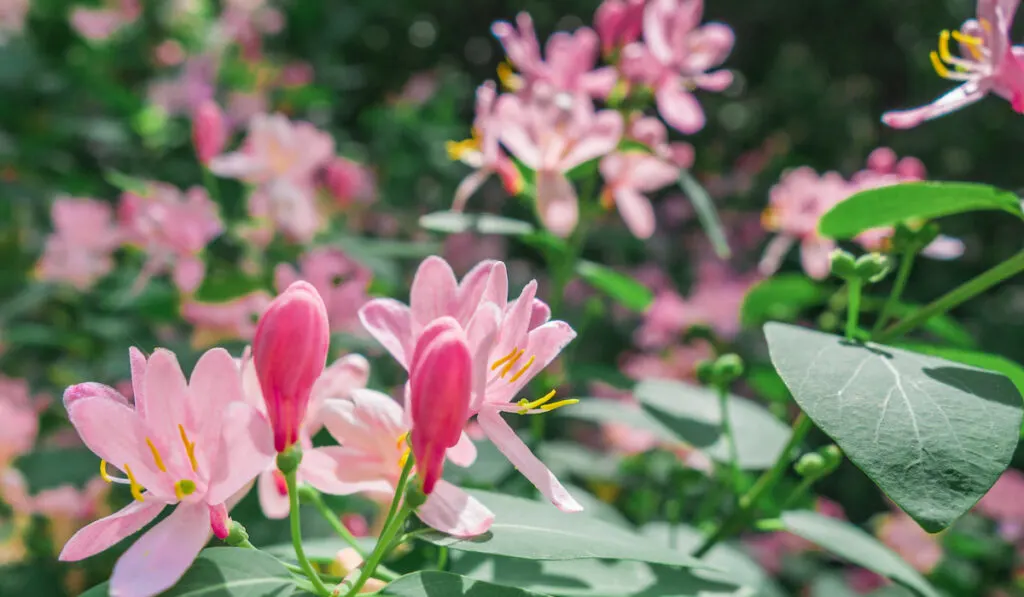The versatility of flowering vines in the garden is vast. Stunning floral displays have the power to transform even the most mundane outdoor area into a vibrant and inviting setting.
Flowering vines take up far less room to expand than trees or bushes do, yet they may provide the same aesthetic benefits as well as additional privacy or camouflage if you need them to.
You can use simple scaffolding, such as trellises, pillars, or even the walls of your home, to guide the growth of your vines in the desired direction, allowing you to shape your garden any way you wish.
To get the best blooming vines for your needs, read on to learn about some great options.
Table of Contents
1. Clematis

| Lifespan | Perennial |
| Flowering Period | Depends on variety |
| Growth Rate | Medium |
| Flowers’ Colors | Extensive selection of colors |
| Height | Depends on variety |
| Spread | Depends on variety |
| Light | Full sun, partial shade |
| Maintenance | Medium |
| Hardiness (Zone) | 3 – 9 |
Among the many flowering vines, Clematis stands out as one of the most appealing and charming. Numerous sizes, hues, and shapes of blooms are readily available.
Gardeners all around the world have developed a deep appreciation for clematis because of the incredible variety of species and flower forms available.
Both spring-only, summer-only, and early-fall-only cultivars exist, in addition to others that bloom continuously throughout the season.
Think about the space you have available for planting before settling on a specific kind. Some species thrive in direct sunlight, while others do well in dappled light.
As a rule of thumb, clematis cultivars with brightly colored blooms need full sun, while those with softer hues or more complex patterns do better in partial light.
2. Climbing Hydrangea

| Lifespan | Perennial |
| Flowering Period | Late spring to early summer |
| Growth Rate | Rapid |
| Flowers’ Color | White |
| Height | 30’ – 40’ |
| Spread | 5’ – 6’ |
| Light | Partial shade, deep shade |
| Maintenance | Low |
| Hardiness | 4 – 9 |
Climbing hydrangea is one of the few floral vines that can thrive in shaded environments.
Climbing hydrangeas can reach heights of more than 40 feet and are known for their showy flower clusters, attractive foliage, and sturdy stems.
Like ordinary ivy, this plant uses aerial roots, which grow at the nodes of its branches, for climbing other plants, structures, and even walls.
In the summer, a Climbing Hydrangea’s oval, deep green foliage blankets the plant, but the leaves take on a warm, golden tint by autumn. And from late spring into early fall, the vine is smothered with huge, fragrant white flowers.
The plant survives in cold climates and has a long life span. It is naturally resistant to both pests and diseases, so there’s no need to take additional care.
3. Bougainvillea

| Lifespan | Perennial |
| Flowering Period | Depending on variety |
| Growth Rate | Rapid |
| Flowers’ Colors | Purple, pink, white, orange, red |
| Height | 8’ – 20’ |
| Spread | 10’ – 40’ |
| Light | Full sun |
| Maintenance | Low |
| Hardiness | 10 – 11 |
Bougainvilleas are tropical shrubs resembling flowering climbing vines. Due to the delicate texture of its flowers, it is also known as a paper flower.
As natives of Brazil and the neighboring countries of eastern South America, these plants thrive in the warm, humid climate of USDA Hardiness Zones 10 and 11.
A little bit of dryness, some full sun, some extra nutrients, and the odd pruning are all this plant requires to thrive. However, keep in mind that their growth rate can exceed 24 inches per year.
So, if you don’t want to ruin your fence, pergola, or home, think carefully about where you’ll place them.
Bougainvillea comes in a wide range of colors, from white and orange to pink and purple to deep crimson.
4. Mandevilla

| Lifespan | Long-living plants in warm climates |
| Flowering Period | From April to October |
| Growth Rate | Rapid |
| Flowers’ Colors | Red, burgundy, pink, white, yellow |
| Height | 3’ – 10’ |
| Spread | 3’ – 4’ |
| Light | Full sun, partial shade |
| Maintenance | Medium |
| Hardiness | 10 – 11 |
Tropical parts of South America are their natural habitats. Nonetheless, the original Mandevilla’s attractive form has led to the creation of other fascinating hybrid varieties.
Mandevillas come in a wide range of colors, from the original red of their enormous velvety blossoms to more modern white and pink varieties.
Mandevilla’s flowers may steal the show, but the plant’s branches and leaves are stunning, too. This gorgeous vine is covered in a thick layer of shiny, leathery, deep green leaves.
Under optimal conditions, mandevilla has a long and abundant blooming season that lasts from April to October. Therefore, continuous fertilization throughout the season is required.
Mandevilla’s native tropical climate makes it well-suited to hot and humid circumstances.
It does well in container settings and can be grown successfully on patios, decks, and balconies.
In warm climates, mandevilla can remain green all year round. But it must be taken indoors for the winter if you live somewhere cold.
5. Wisteria

| Lifespan (annual or perennial) | Long-living plants |
| Flowering Period | Spring |
| Growth Rate | Rapid |
| Flowers’ Colors | Purple, lavender, white |
| Height | 10’ – 30’ |
| Spread | 10’ – 15’ |
| Light | Full sun, partial shade |
| Maintenance | High |
| Hardiness | 5 – 9 |
Wisteria is a stunning example of a flowering vine. Although this vine’s beauty is appreciated year-round, it is especially striking in May when it is in full bloom.
Wisteria is available in various hues ranging from light to dark purple and violet, but it can also be found in white.
This vine is distinguished by the little, pea-like flowers that grow in long, dense clusters and give off a sweet and delicate aroma.
Wisteria can quickly cover a wall. But its growth rate is proportional to the care taken to ensure optimal conditions for development.
Wisteria twines tightly around its trellises. Older examples have thick and powerful shoots resembling large snakes squeezing the climbing structure.
Because of this, wisteria should not be planted near trees since it can strangle them over time.
Some wisteria plants have been known to have lived for over a century! For this reason, wisteria is best suited for cultivation in vast gardens where its rapid expansion over time may be tolerated without difficulty.
It also requires sturdy, solid support that will enable it to ramble over in the future.
6. Black-Eyed Susan Vine

| Lifespan | Perennial in warm climate but mostly an annual plant |
| Flowering Period | From spring till fall |
| Growth Rate | Rapid |
| Flowers’ Colors | Red, rose, orange, yellow, white |
| Height | 3’ – 8’ |
| Spread | 3’ – 6’ |
| Light | Full sun, partial shade |
| Maintenance | Low |
| Hardiness | 10 – 11 |
Though it lives for multiple years in its native tropical environment, the black-eyed Susan vine is more commonly treated as an annual in cultivation. This lovely floral vine requires little effort to maintain.
Black-Eyed Susan Vine has the appearance of daisies, with five overlapping petals of the same color surrounding a brown central tube. Its oppositely growing, green leaves can be heart or lance-shaped and have a slightly gritty texture.
This vigorous climber thrives as a springtime nursery pot plant once the ground has warmed. In just one season, it can grow to be 8 feet in length.
While its lifespan as a warm-climate perennial is limited, its ability to spread by self-seeding makes up for its short lifespan.
7. Honeysuckle

| Lifespan | Perennial |
| Flowering Period | Depending on variety |
| Growth Rate | Rapid |
| Flowers’ Colors | Purple, pink, white, yellow, lavender |
| Height | 15’ – 20’ |
| Spread | 4’ – 6’ |
| Light | Full sun, partial shade |
| Maintenance | Low |
| Hardiness | 4 – 9 |
Honeysuckle is a hardy vine cultivated for its attractive flowers that can be planted nearly anywhere. This is due to the fact that the vine is low-maintenance and grows rapidly.
Because many species of this magnificent vine have a rich, sweet aroma, honeysuckle is a pleasure in the garden that thrills its owner while also attracting bees and butterflies.
Honeysuckle blossoms are long and tube-shaped, and they come in a variety of hues, including white, yellow, red, and violet. The flowers are arranged in clusters at the peaks of the stalks.
Honeysuckle isn’t picky, but you still need to follow some rules to keep it healthy.
Honeysuckle prefers indirect sunlight but not complete shade. Then they can flourish without worrying about drying out. They can also thrive in partial shade, but their flower output will decrease.
Remember that it takes honeysuckle anywhere from two to four years from planting to produce its first flowers.
Final Thoughts
There is a wide variety of flowering vines to choose from, including annuals, perennials, leaves, and flower shapes and sizes, not to mention a rainbow of colors.
If you’re bored with how your fence, wall, gazebo, terrace, or balcony looks, just plant a pretty vine and watch it grow.
Just remember, when making your selection, to take into consideration that different types of vines have varying needs in terms of soil, temperature, and light.
Resources
- https://plants.ces.ncsu.edu/plants/clematis/
- https://plants.ces.ncsu.edu/plants/hydrangea-anomala/
- https://www.gardenia.net/plant/hydrangea-anomala-subsp-petiolaris-climbing-hydrangea
- https://www.gardenia.net/plant/wisteria-sinensis-prolific-chinese-wisteria
- https://plants.ces.ncsu.edu/plants/mandevilla-sanderi/
- https://plants.ces.ncsu.edu/plants/lonicera-x-heckrottii/
- https://www.allaboutgardening.com/trellis-vines/
- https://www.bhg.com/gardening/plant-dictionary/vine/bougainvillea/
- https://gardenerspath.com/plants/vines/grow-bougainvillea/
- https://www.bhg.com/gardening/plant-dictionary/vine/black-eyed-susan-vine/
- https://www.thespruce.com/black-eyed-susan-vine-thunbergia-alata-1402901
